Joe Burrow knows ball. That certainly comes off when watching him operate on the field, but it becomes abundantly clear when you hear him talk in press conferences. The 25-year-old is not just eloquent; he’s also open and insightful about what he and the team are trying to do—a rarity in a league where teams protect even the most basic strategic elements as if they were nuclear codes. For instance, Burrow was asked in July how the Bengals could sustain and build on the success they enjoyed in 2021. Instead of playing the hits—we just gotta keep working to get better, we can’t get complacent, blah, blah, blah—he actually explained how the offense would have to evolve, and the defensive counters that would necessitate that evolution.
It turns out that answer was prophetic. In the Bengals’ season-opening 23-20 loss to Pittsburgh, the Steelers defense played a ton of Cover 2 and took away the explosive downfield throws that had powered Cincinnati’s offense a year before. Burrow threw a career-high four interceptions trying to force the issue. He didn’t throw any picks the following week in Dallas, but another Cover 2–heavy gameplan took away the deep-passing game and forced Burrow to settle for inefficient options underneath in a 20-17 loss. Meanwhile, the Bengals running game continued to be useless, namely because opposing defenses knew that when Burrow was under center Cincinnati was likely going to run, and when he was in shotgun it was going to pass. When a defense can confidently predict what’s coming, moving the ball gets difficult.
After those two games, Cincinnati sat at 0-2 and its offense appeared to be broken. The Bengals ranked 23rd in EPA per play and last in offensive DVOA. Burrow was averaging 4.9 yards per dropback, which ranked 29th at the time, and had completed just one pass over 20 air yards. It was a far cry from the fireworks show this passing game put on last season. But things have changed since then. Cincinnati has won four of its last five, the offense leads the NFL in success rate over that time, and only the Chiefs have been better by EPA. Burrow’s deep-ball magic of 2021 has also returned. He’s completed seven passes over 20 air yards since Week 3, and three of them have gone for touchdowns. Even the running game has been productive during this stretch, thanks in large part to coach Zac Taylor trimming the fat from his early-down offense.
It’s been fascinating to track this resurgence over the past month, and Burrow has been open about discussing it in pressers throughout the season. The question now is whether the changes the Bengals have made will keep the offense humming for the rest of the season, or whether the issues that plagued them early this season will come back to haunt them.
Through the first two weeks of the season, no quarterback had more dropbacks against Cover 2 than Burrow’s 46, according to TruMedia, and Kyler Murray was second with 32. It wasn’t really even close. Soft zone coverages were preventing Burrow from pushing the ball downfield with the same frequency as he did in 2021, but he had a theory on how the Bengals could get defenses out of them.
“It’s give and take,” Burrow said after the Week 2 loss in Dallas. “We think if we start running the ball a little better, then that will open it up and teams will have to get out of 2 Tampa shell. … The first half we were in first-and-15 in every series, so we’re just going to get third-down defenses when we’re in first-and-15. So, we’ve got to eliminate those early penalties, stay on track for the chains, and we’ll be able to take more shots.”
“Cover 2” applies to a broad genre of coverages, but Burrow specifically mentioned 2 Tampa as the variation that had given him and the passing game fits. That coverage is typically reserved for obvious passing situations, and given Cincinnati’s inability to run the football efficiently early in the season, its first two opponents were able to call a bunch of 2 Tampa—which features safety help over the top and corners playing underneath. That’s particularly helpful against a team with two star receivers playing on the perimeter. Burrow suggested that a better run game would help deter those looks.
The Bengals saw less of that coverage in wins over the Dolphins and Jets the next two weeks, but that wasn’t a product of an improved run game. Cincinnati didn’t call a single run while the Jets were in Cover 2, per TruMedia. And against the Dolphins, it called three, which resulted in 10 yards total. Those teams didn’t copy the plans laid out by Pittsburgh and Dallas. They played their normal mix of coverages, which did not include a lot of Cover 2, and Burrow took advantage in a lot of the same ways we saw him dust defenses in 2021. After the first win, Burrow mentioned that getting ahead early allowed the offense to do more to push the ball downfield. After the Miami victory, he said the Dolphins played more man coverage—a bold strategy against Ja’Marr Chase and Tee Higgins—which allowed him to hit on some deeper shots.
The following week, though, the Ravens played a two-high-heavy scheme and Cincinnati’s offense managed just 17 points in a loss that dropped its record to 2-3. After the game, Burrow noted how “soft” the Ravens had played in the secondary, forcing the Bengals to string together long drives to put up points.
“Yeah, it had to be that way,” he said after the Sunday Night Football defeat. “They were taking away all of our deep shots. Even when they were playing man, they were playing pretty soft—[on the] high hip [of receivers]—I thought, for the most part. They did a good job of making us check it down and making us have these long 12-, 15-play drives.”
Like the Steelers and Cowboys before them, the Ravens played a lot of two-high coverages. And given the issues the Bengals had passing the ball, the game appeared to be a setback for the offense. But Burrow didn’t see it that way. He was able to find a silver lining that would prove to be a sign of good things to come: “We got the running game going in the second half against that soft zone, which we weren’t able to quite get it going in the first half. … We really figured out the [shot]gun run game in the second half.”
In the Baltimore game, Cincinnati scrapped almost all of its under-center calls and replaced them with more spread-out shotgun formations. Since then, the Bengals have continued to spread things out and now lead the NFL in average formation width, per Next Gen Stats.
The Bengals Offense Is Spreading Out on Early Downs
What does that mean? With fewer condensed sets, there are fewer defenders in the run box and more space for the running backs to attack. After running against a bunch of heavy boxes over the first month of the season, the Bengals have led the NFL in light-box run rate over the past three weeks, per Sports Info Solutions, and the running game has instantly improved.
The Bengals Are Running Into Lighter Boxes
Getting in the gun more also allowed the Bengals to call run-pass options. Over the first four weeks of the season, the Bengals called RPOs on just 5 percent of their plays, which ranked 22nd in the league, according to Sports Info Solutions. That rate has jumped to 16 percent over the past three games, the fifth-highest mark in the NFL.
RPOs are run plays when a receiver (and sometimes multiple receivers) run pass routes designed to punish defenses that commit too many numbers to stopping the run. Here’s a good example from the Bengals’ Week 6 win over the Saints. Burrow is reading the highlighted linebacker here:
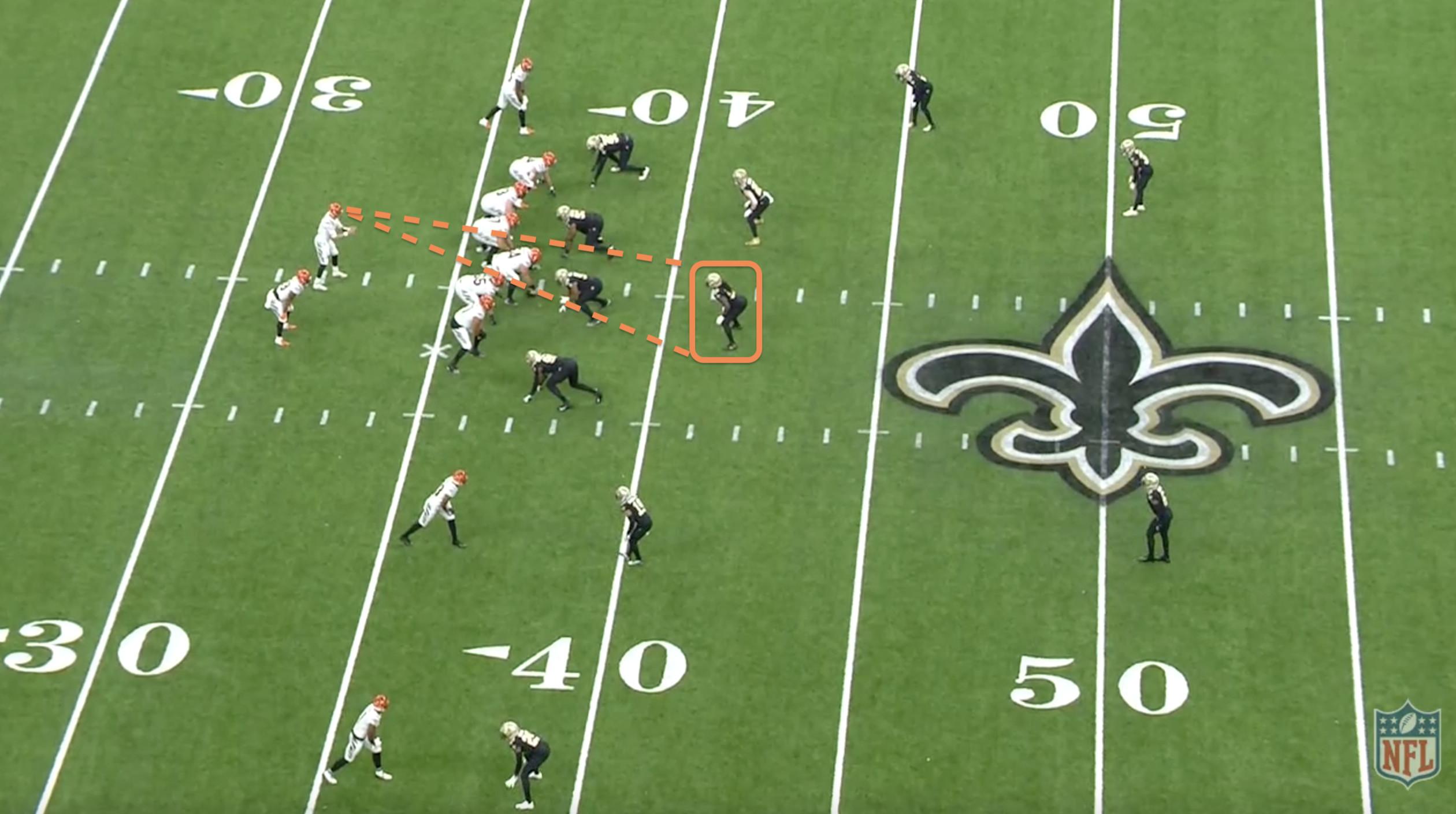
And because he stays in the box to defend the run rather than drop in coverage, Burrow pulls the ball and makes the throw to Tyler Boyd for a first down.
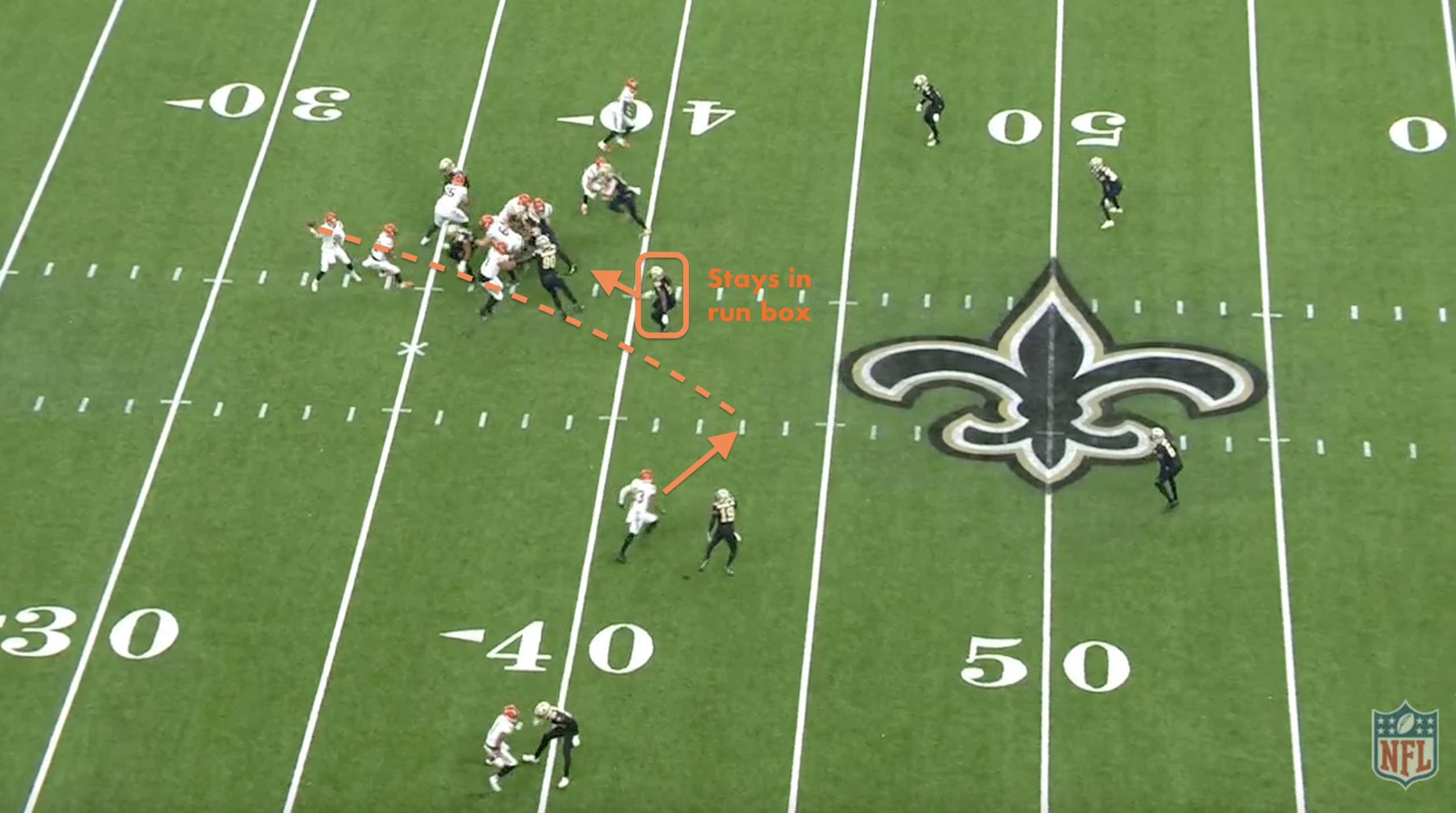
Against Baltimore, the Bengals, with their new spread-run game, averaged 4.8 yards per carry. But even that improvement didn’t get the defense out of those Cover 2 looks. Instead, the Ravens went out of their way to disguise their intentions before the snap. And the disguises worked! On plays when Baltimore had just one safety deep before the snap and then rotated into a two-deep coverage, Burrow averaged minus-0.9 EPA per play with a success rate of 16.7 percent, according to Pro Football Focus. His head-scratching third-quarter interception, thrown right at Patrick Queen’s chest, was one of those plays.
Even when they weren’t playing Cover 2, the Ravens kept Cincinnati from throwing deep by staying over the top of routes, or on the “high hip,” as Burrow put it. It’s a tactic that teams have been using this season against Bengals receivers to take away their go routes. I think that’s when the flip switched for Burrow: It wasn’t going to be the run game that would get defenses out of the 2 Tampa looks. If the Bengals wanted defenses to press up, they’d have to attack the space given up underneath. The coaching staff responded by giving him more opportunities to do that.
Over the past two weeks, 85 percent of Burrow’s dropbacks have been of the one-to-three-step variety—what coaches would refer to as “quick game.” That’s an 18-percentage-point jump from the first five games of the season, when the Bengals were calling more play-action and deeper dropback concepts, and it now leads the NFL, per Sports Info Solutions. The increased usage of RPOs has also allowed Burrow to attack that underneath space and get the ball out of his hands quickly.
“The RPOs were really good to us [today],” Burrow said after the win in New Orleans. “The offensive line played great, and when you get the ball out that fast, the defensive line kind of gets a little frustrated. Maybe they don’t rush as hard or try to bat balls. And then you saw on the last drive people come up and become more aggressive on defense. That’s when you can take the shots.”
Against the Saints, the offense stalled on its first two drives, but it took off once it fully committed to the quick-passing game. The Bengals scored on every drive following that strategic shift en route to a come-from-behind 30-26 win.
“I think we know who we are now,” Burrow said after the game. “For the last three quarters of the game, we were pretty lights-out.”
The increase in quick passes has coincided with the reemergence of slot receiver Tyler Boyd. After catching 15 passes in the first five games, Boyd has 14 receptions in the past two, including an eight-catch, 155-yard performance against the Falcons in a 35-17 win last Sunday. Taylor attributed Boyd’s increase in targets to Cincinnati getting “back to the basics in our passing game.”
“Just cornbread and butter stuff that allows the ball to be split around, and just let T.B.—let us give it to Boyd there,” Taylor said. “They’re trying to help on Ja’Marr and Tee, as well, on the outside, so it opens it up for guys like … T.B.”
Part of what’s allowed that to happen is the Bengals’ use of more empty formations, something they did quite a bit in 2021. With five receivers lined up across the width of the field, the defense is stretched thin, creating bigger voids in the coverage for Burrow. That’s something the young quarterback is particularly good at, as he explained to The Ringer’s Kevin Clark last year.
“I like having as many routes available to me as possible,” he said. “Five people out in the route just to stress the defense. Because what I’m good at is feeling space, feeling defenders, feeling where they’re supposed to go, feeling the zones that open up behind them.”
Defenses that have had success against Burrow and this passing game over the past two seasons have done a good job of presenting space before the snap and then closing it off after, which can throw off the quarterback’s timing. The Steelers, Ravens, and Cowboys all changed the picture on Burrow and baited him into throws to covered receivers. Here’s an example from the Baltimore game. The Ravens come out with just one safety deep, and the corner to the top of the screen is playing off.
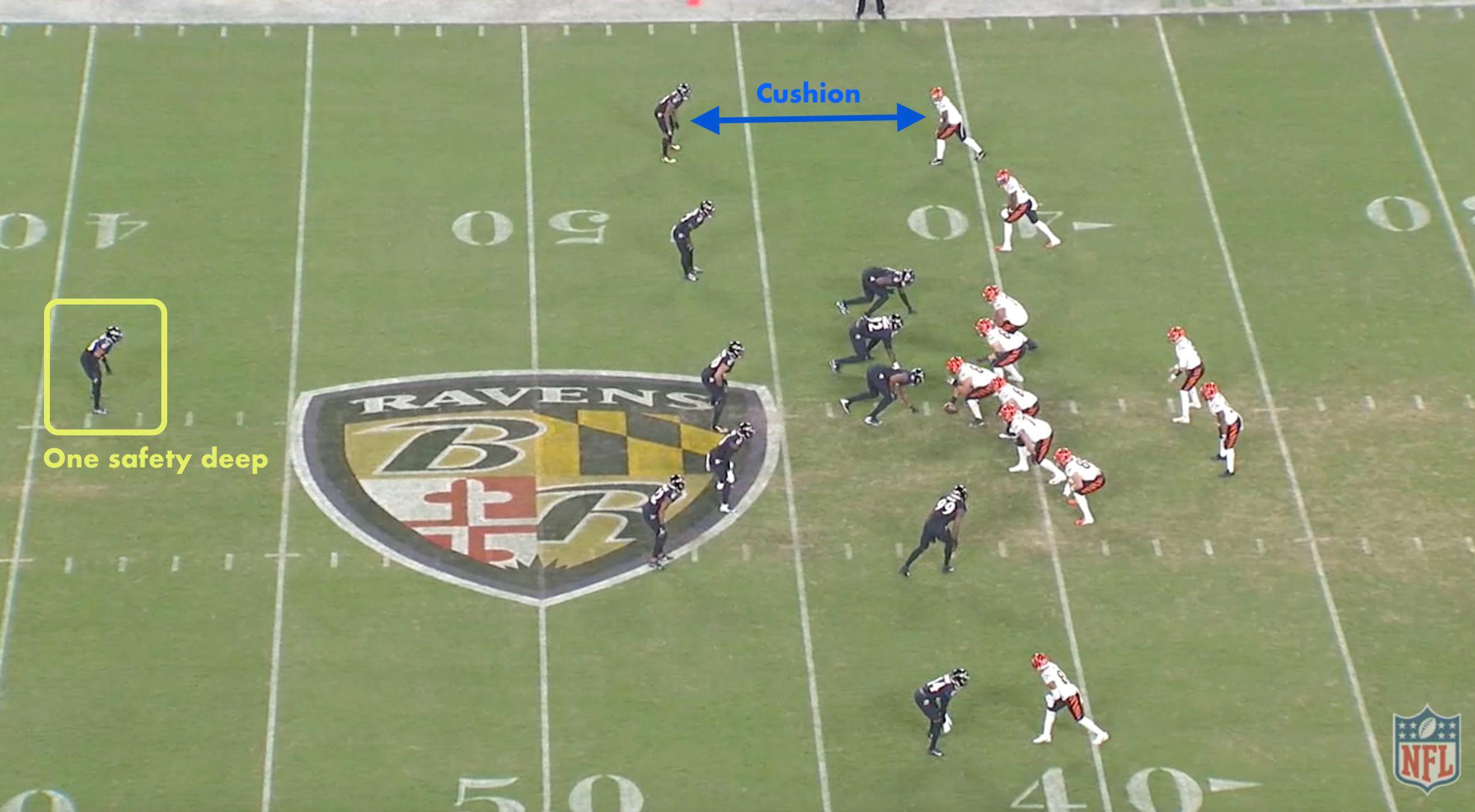
This looks like Cover 3, which would typically have the corner bail to a deep zone, leaving space underneath for a quick stop route.
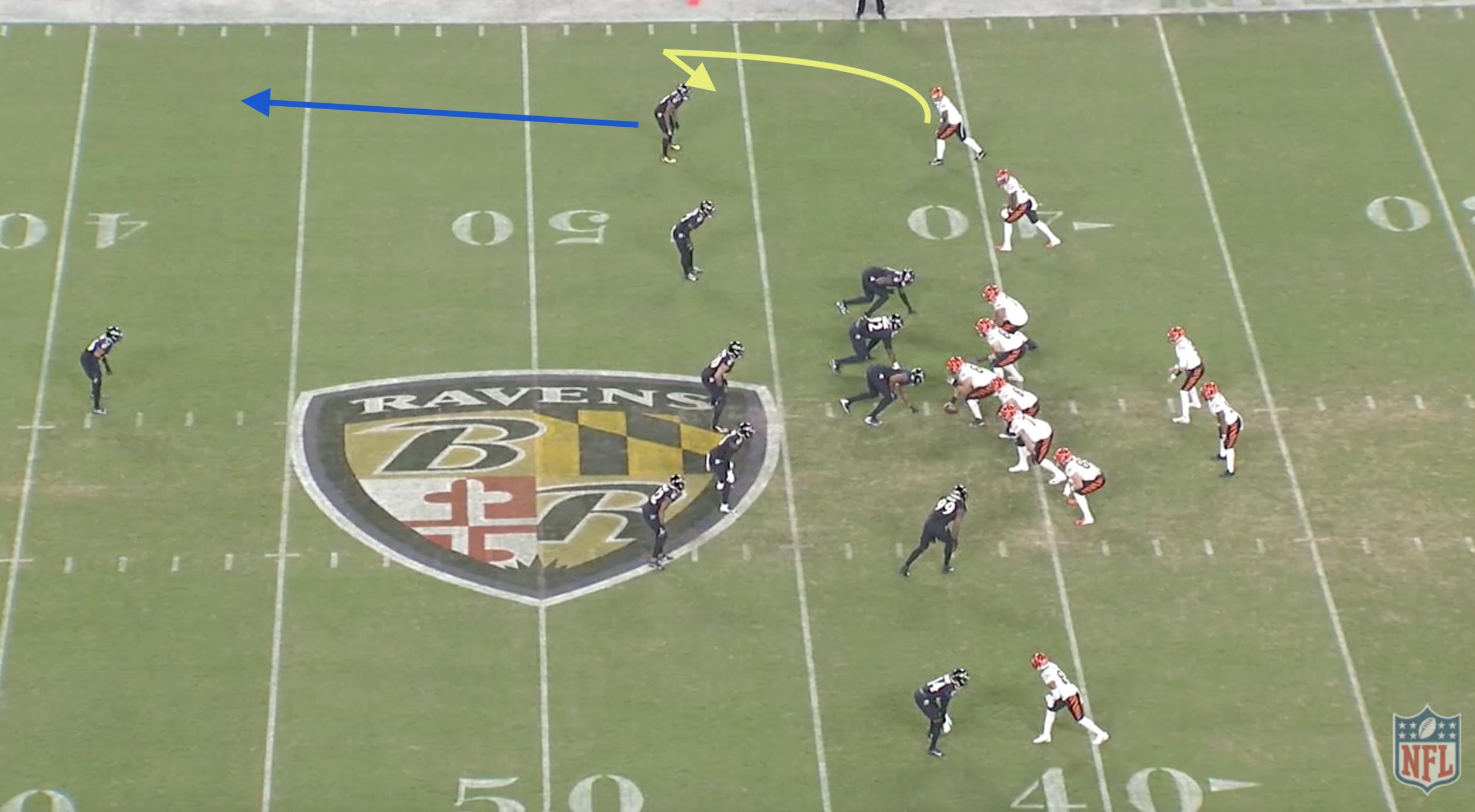
But after the snap, the Ravens rotate into Cover 2, and instead of bailing, the cornerback closes down the space Burrow was planning to attack and he’s forced to throw to a covered receiver.
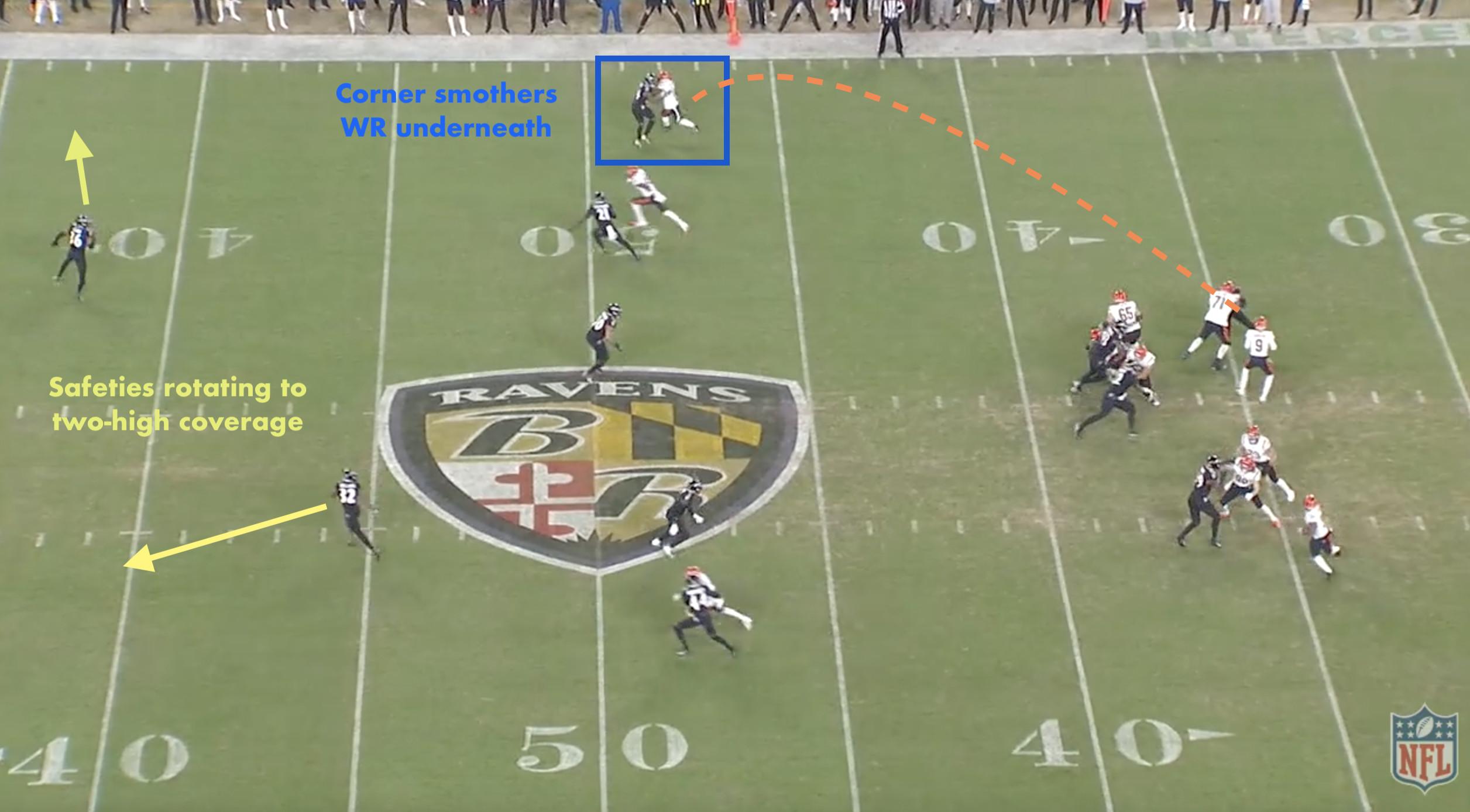
According to one anonymous defensive coordinator who spoke to The Athletic’s Mike Sando, that’s the book on Burrow.
“He predetermines a lot of his quick game,” the coordinator said. “They’ll spread it out and try to show him the picture. When you can change the look for him, I think the kid locks in and some of these guys. Once you get a book on them a little bit, you can make these guys struggle a little.”
The key part of that is the last two words: “a little.” Burrow is a smart dude, so you’re not going to fool him often. But you don’t even stand a chance if you’re not making him do some guesswork before the snap. When Burrow gets a feel for what the defense is doing and is able to get in a rhythm, the Bengals are awfully hard to stop, as the Falcons found out on Sunday when they gave up nearly 500 passing yards.
The long touchdown pass to Boyd on the opening drive offers a good example of how giving Burrow a static pre-snap look can be costly. Atlanta comes out in an alignment that screams 2 Tampa, and Taylor said the Bengals were anticipating that look before the snap. At that point, the read was fairly simple for Burrow:
“They play 2 Tampa, and we held the Tampa [linebacker] with the play fake,” Burrow explained after the game.
In that coverage, the middle linebacker is supposed to cover the deep middle to prevent a receiver from splitting the two deep safeties. The play fake held the linebacker long enough to prevent him from running with Boyd. The safety falling down also helped, but it would have been hard for him to get over the top of the streaking receiver anyway.
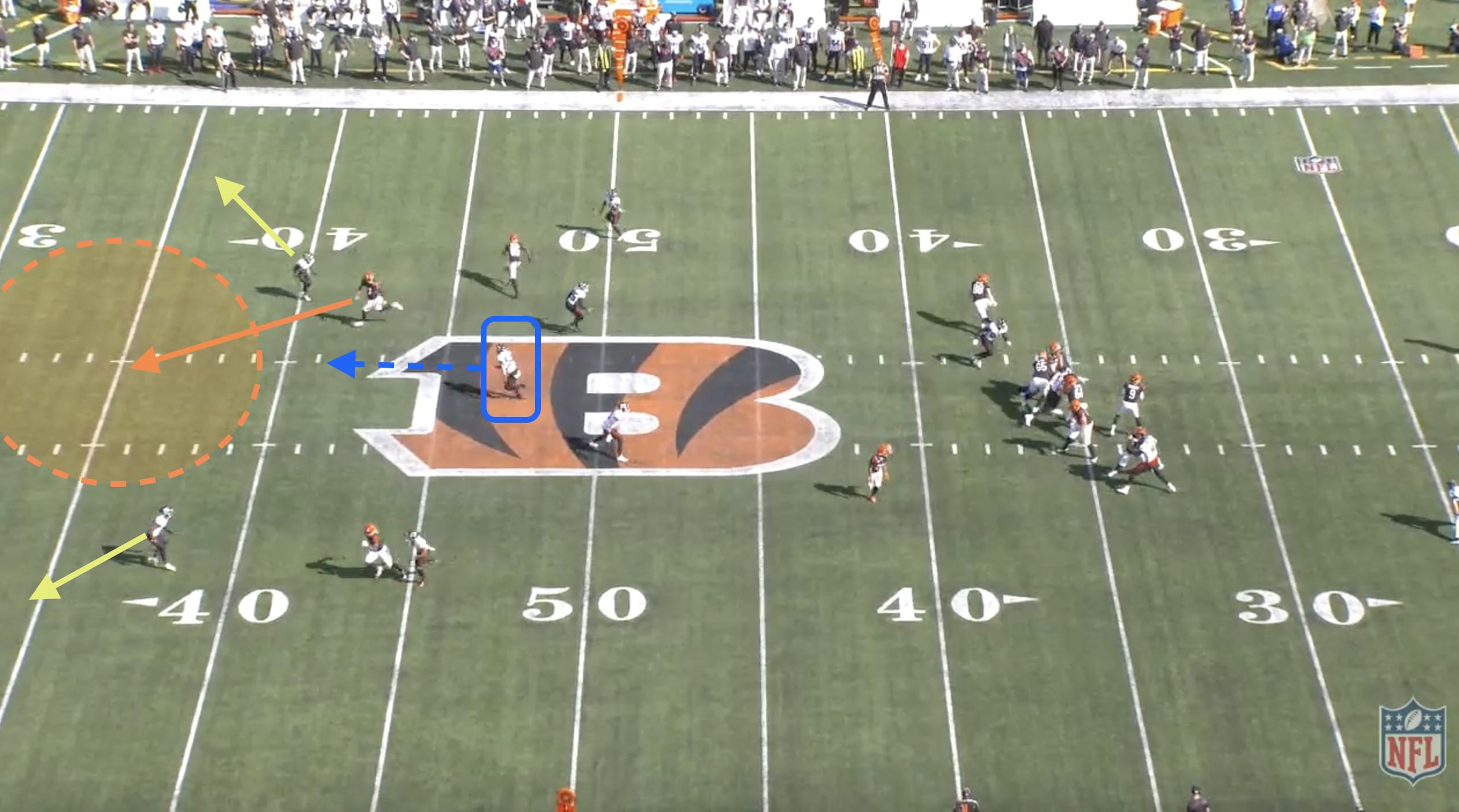
“We saw a lot of spots on film that we could take advantage of,” Burrow said after the game. “We jumped out early on them. They ended up putting in an extra defensive lineman in there to get some pressure. The line did a great job handling that, so we spread them out and let our guys go make plays.”
Falcons defensive coordinator Dean Pees then dialed up more pressure, which created even more space for the Bengals to attack. And that increased aggression also created one-on-one matchups for Chase on the outside, which Burrow attacked relentlessly. Both of Chase’s touchdowns came against single-high coverage that left him one-on-one with a corner, including a perimeter “go” ball that felt like a flashback to the 2021 season.
“We jumped out early today, made them play more aggressive,” Burrow said in the postgame presser. “Last week [against the Saints] we moved the ball up and down the field, taking what the defense gave us. When you take those check downs and turn them into 8 yards up and down, defenses get impatient. Then they get more aggressive, so we have more [downfield] opportunities.”
The improved running game has helped to keep the offense ahead of the chains and out of obvious passing situations; and, more importantly, the Bengals are no longer wasting downs on unproductive runs into loaded boxes. But it’s not really the driving factor in the return of the downfield passing game, as Burrow had predicted. Instead, Cincinnati got back to its big-play roots over the past two weeks by leaning on the spread concepts Burrow favors even more than they had in the past—concepts it had cut down on early this season while trying to run Taylor’s preferred style of offense, which is greatly influenced by his old boss Sean McVay. The Bengals offense now looks nothing like the one Taylor was hired to install. Instead, it looks more like the spread offenses we’ve seen Kansas City and Buffalo employ in past seasons. Those units eventually ran into trouble when defenses adjusted and forced them to diversify their scheme. Which raises the question: How long will this current setup keep working for Cincinnati?
Burrow’s not sure himself, and he’s mentioned on multiple occasions that the tactics that have served the offense so well over the last two wins were largely dictated by what the Saints and Falcons defenses threw at them.
“One week we might throw a bunch of RPOs like last week,” Burrow said a few days after the New Orleans win. “The next week we might be able to be a downhill run team. We’ll have to see. Every defense is different so every game plan calls for something else. … [RPOs are] good against some teams and not good against others.”
Following the win over Atlanta, the young signal-caller suggested that defensive adjustments may force the Bengals to dust off the parts of the offense they removed from the call sheet to help spark this turnaround.
“[The gun] is where we’ve made our money the last few weeks,” Burrow said. “We’ll see how it is going forward; maybe we start to see some tighter boxes since we’ve been running it so well out of the gun. Maybe we get back under center and it opens up those play-actions and under-center runs. We’ll see what happens; it depends on the game plan.”
It’s hard to win in today’s NFL without a diverse offense. That has been one of the major themes of the 2022 season, in which we’ve seen a decline in scoring and passing efficiency across the league. So while the Bengals have turned around their season by fully committing to a spread attack—in both the run and pass games—better competition, equipped with more film, will eventually force them to come up with a good Plan B. That’s what Burrow seems to be bracing for, at least.
This recent stretch has proved the offense will continue to work if it’s able to get defenses out of soft zone looks with a quick passing game and spread run game. But what will happen when a team is able to stay in those looks while giving Burrow more to think before the snap, as the Ravens did two weeks ago? That question has yet to be answered—and it could ultimately be what determines whether this team can make another run to the Super Bowl.
